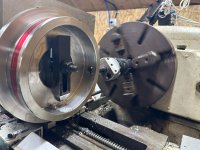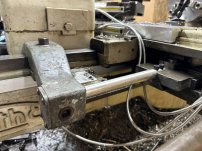FJsapper
Cast Iron
- Joined
- Nov 18, 2020
- Location
- Sterling Heights, MI
Follow along with the video below to see how to install our site as a web app on your home screen.
Note: This feature may not be available in some browsers.
Well, without any other context, I’d say yes?
 or maybe how old your machinery is.
or maybe how old your machinery is.You nailed it, thanks! Upon closer inspection the back side of the fuse lists the wire gauge spec for each amp load. Without understanding that these were rebuildable I failed to put 2 and 2 together.FJsapper,
Apologies for not explaining my post - I thought it possible you might not have come across the type of fuse where you simply replace the fuse wire. I have them in my 1950's house (ceramic versions), but a modern house or a machine would not have them.
It probably depends how old you areor maybe how old your machinery is.



In my experience the plate on the front of the headstock usually tells you if the machine is a roller bearing machine or not.Can you any of you knowledgeable folks tell me, if I was standing in front of a T17, how would I
1) tell if its the roller bearings or plain bearing headstock
2) whether its a D1-8 cam lock or their quick mount system
I'm looking at one and just want to know what I'm getting into. I have a 13x42 so am part of club and need no convincing on them, but the T17 has some uniqueness that makes it new to me.
Any chance there is a pdf of manual kicking around, hopefully for free
Nice progress on the lathe.
Since all T17 folks are here, can you any of you knowledgeable sorts tell me, if I was standing in front of a T17, how would I
1) tell if its the roller bearings or plain bearing headstock
2) whether its a D1-8 cam lock or their quick mount system
I'm looking at one and just want to know what I'm getting into. I have a 13x42 so am part of club and need no convincing on them, but the T17 has some uniqueness that makes it new to me.
Any chance there is a pdf of manual kicking around, hopefully for free (would like to read it before buying the lathe)

As has been said, the serial/model plate on the headstock should say roller or plain bearing.Nice progress on the lathe.
Since all T17 folks are here, can you any of you knowledgeable sorts tell me, if I was standing in front of a T17, how would I
1) tell if its the roller bearings or plain bearing headstock
2) whether its a D1-8 cam lock or their quick mount system
I'm looking at one and just want to know what I'm getting into. I have a 13x42 so am part of club and need no convincing on them, but the T17 has some uniqueness that makes it new to me.
Any chance there is a pdf of manual kicking around, hopefully for free (would like to read it before buying the lathe)



That’s the way mine is set up, plain bearing front and two rollers middle and aft. It came from an auction just outside of Warner Robbins from a factory that apparently fell in on an old Lockheed operation when it shut down. Not sure if there is any difference between mine and the Rolls machines, it sure makes a nice cut though….you know, when you accidentally stumble on that magic RPM/insert combo?Amazing. In my dreams I find a DS&G 17T "special" like they made for Rolls-Royce with both the roller bearings and the huge hand scraped white bearing. Even ordinary DS&G lathes are super rare Stateside with the toolroom lathes even more so. Incredible find and count me as jealous...
Notice
This website or its third-party tools process personal data (e.g. browsing data or IP addresses) and use cookies or other identifiers, which are necessary for its functioning and required to achieve the purposes illustrated in the cookie policy. To learn more, please refer to the cookie policy. In case of sale of your personal information, you may opt out by sending us an email via our Contact Us page. To find out more about the categories of personal information collected and the purposes for which such information will be used, please refer to our privacy policy. You accept the use of cookies or other identifiers by closing or dismissing this notice, by scrolling this page, by clicking a link or button or by continuing to browse otherwise.
